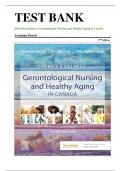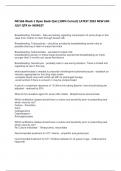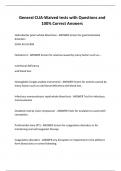TEST BANK
Ebersole and Hess' Gerontological Nursing and Healthy Aging in Canada
Veronique Boscart
3RD Edition
TEST BANK
,Chapter 01: Introduction to Healthy Aging
Touhy & Jett: Ebersole and Hess’ Gerontological Nursing & Healthy Aging, 3rd
Edition
MULTIPLE CHOICE
1. A man is terminally ill with end-stage prostate cancer. Which is the best statement about this
man’s wellness?
a. Wellness can only be achieved with aggressive medical interventions.
b. Wellness is not a real option for this client because he is terminally ill.
c. Wellness is defined as the absence of disease.
d. Nursing interventions can help empower a client to achieve a higher level of
wellness.
ANS: D
Nursing interventions can help empower a client to achieve a higher level of wellness; a nurse
can foster wellness in his or her clients. Wellness is defined by the individual and is
multidimensional. It is not just the absence of disease. A wellness perspective is based on the
belief that every person has an optimal level of health independent of his or her situation or
functional level. Even in the presence of chronic illness or while dying, a movement toward
wellness is possible if emphasis of care is placed on the promotion of well-being in a
supportive environment.
PTS: 1 DIF: Apply REF: p. 7 TOP: Nursing Process: Diagnosis
MSC: Health Promotion and Maintenance
2. In differentiating between health and wellness in health care, which of the following
statements is true?
a. Health is a broad term encompassing attitudes and behaviors.
b. The concept of illness prevention was never considered by previous generations.
c. Wellness and self-actualization develop through learning and growth.
d. Wellness is impossible when one’s health is compromised.
ANS: A
Health is a broad term that encompasses attitudes and behaviors; holistically, health includes
wellness, which involves one’s whole being. The concept of illness prevention was never
considered by previous generations; throughout history, basic self-care requirements have
been recognized. Wellness and self-actualization develop through learning and growth—as
basic needs are met, higher level needs can be satisfied in turn, with ever-deepening richness
to life. Wellness is possible when one’s health is compromised—even with chronic illness,
with multiple disabilities, or in dying, movement toward a higher level of wellness is possible.
PTS: 1 DIF: Understand REF: p. 7 TOP: Nursing Process: Evaluation
MSC: Health Promotion and Maintenance
3. Which racial or ethnic group has the highest life expectancy in the United States?
a. Native Americans
b. African Americans
c. Hispanic Americans
d. Asian and Pacific Island Americans
, Chapter 02: Cross-Cultural Caring and Aging
Touhy & Jett: Ebersole and Hess’ Gerontological Nursing & Healthy Aging, 3rd
Edition
MULTIPLE CHOICE
1. Which of the following is a true statement about differing health belief systems?
a. Personalistic or magicoreligious beliefs have been superseded in Western minds by
biomedical principles.
b. In most cultures, older adults are likely to treat themselves using traditional
methods before turning to biomedical professionals.
c. Ayurvedic medicine is another name for traditional Chinese medicine.
d. The belief that health depends on maintaining a balance among opposite qualities
is characteristic of a magicoreligious belief system.
ANS: B
Older adults in most cultures usually have had experience with traditional methods that have
worked as well as expected. After these treatments fail, older adults turn to the formal health
care system. Even in the United States, it is common for older adults to pray for cures or
wonder what they did to incur an illness as punishment. The Ayurvedic system is a
naturalistic health belief system practiced in India and in some neighboring countries. This
belief is characteristic of a holistic or naturalistic approach.
PTS: 1 DIF: Understand REF: p. 16-17
TOP: Nursing Process: Assessment MSC: Health Promotion and Maintenance
N R I G B. C M
2. Which nof nthe nfollowing nconsidU
eratiS
onsNis m
Tost nlikO
ely nto nbe ntrue nwhen nworking
nwith nan ninterpreter?
a. An ninterpreter nis nnever nneeded nif nthe nnurse nspeaks nthe nsame nlanguage nas nthe npatient.
b. When nworking nwith ninterpreters, nthe nnurse ncan nuse ntechnical nterms nor nmetaphors.
c. A npatient’s nyoung ngranddaughter nwho nspeaks nfluent nEnglish nwould nmake
nthe nbestninterpreter nbecause nshe nis nfamiliar nwith nand nloves nthe npatient.
d. The nnurse nshould nface nthe npatient nrather nthan nthe ninterpreter.
ANS: n D
The nnurse nshould nface nthe npatient nrather nthan nthe ninterpreter nis na ntrue nstatement; nthe
nintent nis nto nconverse nwith nthe npatient, nnot nwith na nthird nparty nabout nthe npatient. nMany
nreasons nmay nprevent nthe npatient nfrom nspeaking ndirectly nto na nnurse. nTechnical nterms
nand nmetaphors nmay nbe ndifficult nor nimpossible nto ntranslate. nCultural nrestrictions nmay
nprevent nsome ntopics nfrom nbeing nspoken nofnto na ngrandparent nor nchild.
PTS: n n n 1 DIF: n n n Understand n n n REF: n n np. n18-19
TOP: n Nursing nProcess: nImplementation n n n MSC: n Safe, nEffective nCare nEnvironment
3. An nolder nadult nwho nis na ntraditional nChinese nman nhas na nblood npressure nof n80/54 nmm
nHg nand nrefuses nto nremain nin nthe nbed. nWhich nintervention nshould nthe nnurse nuse nto
npromote nand nmaintainnhis nhealth?
a. Have nthe nhealth ncare nprovider nspeak nto nhim.
b. Use nprinciples nof nthe nholistic nhealth nsystem.
c. Ask nabout nhis nperceptions nand ntreatment nideas.
, d. Consult nwith na npractitioner nof nChinese nmedicine.
ANS: n C
Using nthe nLEARN nmodel n(listen nwith nsympathy nto nthe npatient’s nperception nof nthe
nproblem, nexplain nyour nperception nof nthe nproblem, nacknowledge nthe ndifferences nand
nsimilarities, nrecommend ntreatment, nand nnegotiate nagreement), nthe nnurse ngathers
ninformation nfrom nthe npatient nabout ncultural nbeliefs nconcerning nhealth ncare nand navoids
nstereotyping nthe npatient. nIn nthenassessment, nthe nnurse ndetermines nwhat nthe npatient
nbelieves nabout ncaregiving, ndecision nmaking,ntreatment, nand nother npertinent nhealth-related
ninformation. nSpeaking nwith nthe nhealth ncare nprovider nis npremature nuntil nthe nassessment
nis ncomplete. nUnless nhe naccepts nthe nbeliefs, nprinciples nof nthe nholistic nhealth nsystem
ncan nbe npotentially nunsuitable nand ninsulting nfor nthis npatient. nUnless nhe naccepts nthe
ntreatments, nconsulting nwith na npractitioner nof nChinese nmedicine ncan nalso nbe nunsuitable
nand ninsulting nfor nthis npatient.
PTS: n n n 1 DIF: Apply REF: n p. n18
TOP: n Nursing nProcess: nImplementation MSC: n Health nPromotion nand nMaintenance
4. Which naction nshould nthe nnurse ntake nwhen naddressing nolder nadults?
a. Speak nin nan nexaggerated npitch.
b. Use na nlower nquality nof nspeech.
c. Use nendearing nterms nsuch nas n“honey.”
d. Speak nclearly.
ANS: n D
Some nhealth nprofessionals ndemonstrate nageism, nin npart nbecause nproviders ntend nto
nsee nmanynfrail, nolder npersons nand nfewer nof nthose nwho nare nhealthy nand nactive.
nProviders nshould nnot
assume nthat nall nolder nadults nare nhearing nor nmentally nimpaired. nThe nmost nappropriate
naction nwhen naddressing nan nolder nadu NltUwRoSulIdNbeGtTo Bsp.eC
akOcM
learly. nExamples nof
nunintentional nageism nin nlanguage nare nan nexaggerated npitch, na ndemeaning nemotional
ntone, nand na nlower nquality nof
speech.
PTS: n n n 1 DIF: Apply REF: n p. n15
TOP: n Nursing nProcess: nAssessment MSC: n Health nPromotion nand nMaintenance
5. The nnurse nprepares nan nolder nwoman, nwho nis nPolish, nfor ndischarge nthrough nan
ninterpreter nand nnotes nthat nshe nbecomes ntense nduring nthe ninstructions nabout
nelimination. nWhich nintervention nshould nthe nnurse nimplement?
a. Move non nto nthe ndiscussion nabout nmedication.
b. Ask nthe nolder nwoman nhow nshe nfeels nabout nthis ntopic.
c. Instruct nthe ninterpreter nto nrepeat nthe ninstructions.
d. Have nthe nolder nwoman nrepeat nthe ninstructions nfor nclarity.
ANS: n B
When nworking nwith nan ninterpreter, nthe nnurse nclosely nwatches nthe nolder nadult nfor
nnonverbal ncommunication nand nemotion nregarding na nspecific ntopic nand ntherefore
nvalidates nthe nassessment nabout nthe nolder nadult’s ntension nbefore nproceeding. nBecause
nthe nnurse nnotices nher ntension, nthe nnurse ntemporarily nsuspends nthe npreparation nto
nvalidate nher nassessment. nIf nthe nnurse nproceeds nand nthe nolder nadult nis nuncomfortable
ndiscussing nelimination, nthen nimportant ninstructions ncan nbenmissed, nleading nto nadverse
neffects nfor nthe nolder nadult. nRepeating nthe ninstructions ncan naggravatenthe nolder nadult’s
ndiscomfort. nInstructing nthe nolder nadult nto nrepeat nthe nnurse’s ninstruction nignores nher
nneeds.






